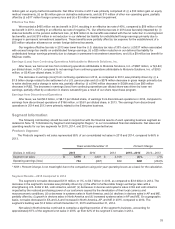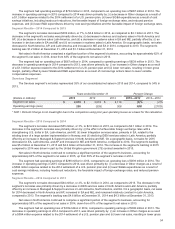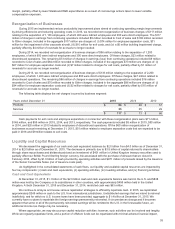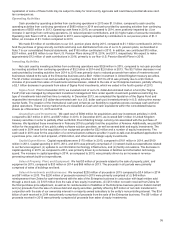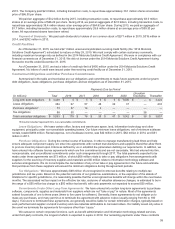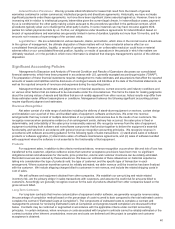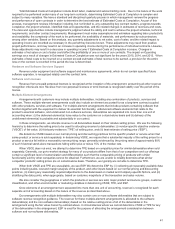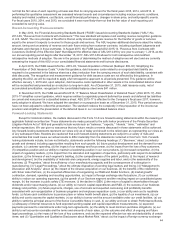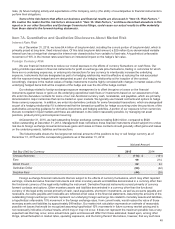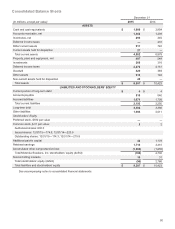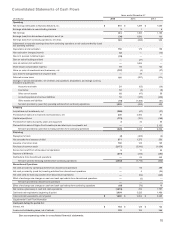Motorola 2015 Annual Report Download - page 43
Download and view the complete annual report
Please find page 43 of the 2015 Motorola annual report below. You can navigate through the pages in the report by either clicking on the pages listed below, or by using the keyword search tool below to find specific information within the annual report.
42
We allocate arrangement consideration to multiple software or software-related deliverables, including the sale of software
upgrades or software support agreements to previously sold software, in accordance with software accounting guidance. For
such arrangements, revenue is allocated to the deliverables based on the relative fair value of each element of the software, and
fair value is determined using VSOE. Where VSOE does not exist for the undelivered software element, revenue is deferred until
either the undelivered element is delivered or VSOE is established, whichever occurs first. When the final undelivered software
element is post contract support, service revenue is recognized on a ratable basis over the remaining service period. When
VSOE of a delivered element has not been established, but VSOE exists for the undelivered elements, we use the residual
method to recognize revenue when the fair value of all undelivered elements is determinable. Under the residual method, the fair
value of the undelivered elements is deferred and the remaining portion of the arrangement consideration is allocated to the
delivered elements and is recognized as revenue.
Inventory Valuation
We record valuation reserves on our inventory for estimated excess or obsolescence. The amount of the reserve is equal
to the difference between the cost of the inventory and the estimated market value based upon assumptions about future
demand and market conditions. On a quarterly basis, management performs an analysis based on future demand requirement
estimates of the underlying inventory to identify reserves needed for excess and obsolescence. In addition, we adjust the
carrying value of inventory if the current market value of that inventory is below our cost.
At December 31, 2015 and 2014, Inventories consisted of the following:
December 31 2015 2014
Finished goods $ 151 $163
Work-in-process and production materials 287 313
438 476
Less inventory reserves (142) (131)
$ 296 $345
We balance the need to maintain strategic inventory levels to ensure competitive delivery performance to our customers
against the risk of inventory obsolescence due to rapidly changing technology and customer requirements. As reflected above,
our inventory reserves represented 32% of the gross inventory balance at December 31, 2015, compared to 28% of the gross
inventory balance at December 31, 2014. We have inventory reserves for excess inventory, pending cancellations of product
lines due to technology changes, long-life cycle products, lifetime buys at the end of supplier production runs, business exits,
and a shift of production to outsourced manufacturing.
If future demand or market conditions are less favorable than those projected by management, additional inventory
writedowns may be required.
Income Taxes
We record deferred income tax assets and liabilities based on the estimated future tax effects of differences between the
financial and tax bases of assets and liabilities based on currently enacted tax laws. The Company’s deferred and other tax
balances are based on management’s interpretation of the tax regulations and rulings in numerous taxing jurisdictions. Income
tax expense and liabilities recognized by the Company also reflect our best estimates and assumptions regarding, among other
things, the level of future taxable income, the effect of the Company’s various tax planning strategies and uncertain tax positions.
Future tax authority rulings and changes in tax laws and projected levels of taxable income and future tax planning strategies
could affect the actual effective tax rate and tax balances recorded by the Company. We evaluate deferred income tax asset
balances on a quarterly basis to determine if valuation allowances are required by considering available evidence, including
historical and projected taxable income and tax planning strategies that are both prudent and feasible. Tax related interest and
penalties are classified as a component of interest expense.
Retirement Benefits
Our benefit obligations and net periodic pension cost (benefits) associated with our domestic noncontributory pension
plans (“U.S. Pension Benefit Plans”), our foreign noncontributory pension plans (“Non-U.S. Plans”), as well as our domestic
postretirement health care plan (“Postretirement Health Care Benefits”), are determined using actuarial assumptions. The
assumptions are based on management’s best estimates, after consulting with outside investment advisors and actuaries.
Accounting methodologies use an attribution approach that generally spreads the effects of individual events over the
service lives of the participants in the plan, or estimated average lifetime when almost all of the plan participants are considered
"inactive." Examples of “events” are plan amendments and changes in actuarial assumptions such as discount rate, expected
long-term rate of return on plan assets, and rate of compensation increases.
There are various assumptions used in calculating the net periodic benefit expense and related benefit obligations. One of
these assumptions is the expected long-term rate of return on plan assets. The required use of the expected long-term rate of
return on plan assets may result in recognized pension income that is greater or less than the actual returns of those plan assets
in any given year. Over time, however, the expected long-term returns are designed to approximate the actual long-term returns.
We use a five-year, market-related asset value method of recognizing asset related gains and losses.



